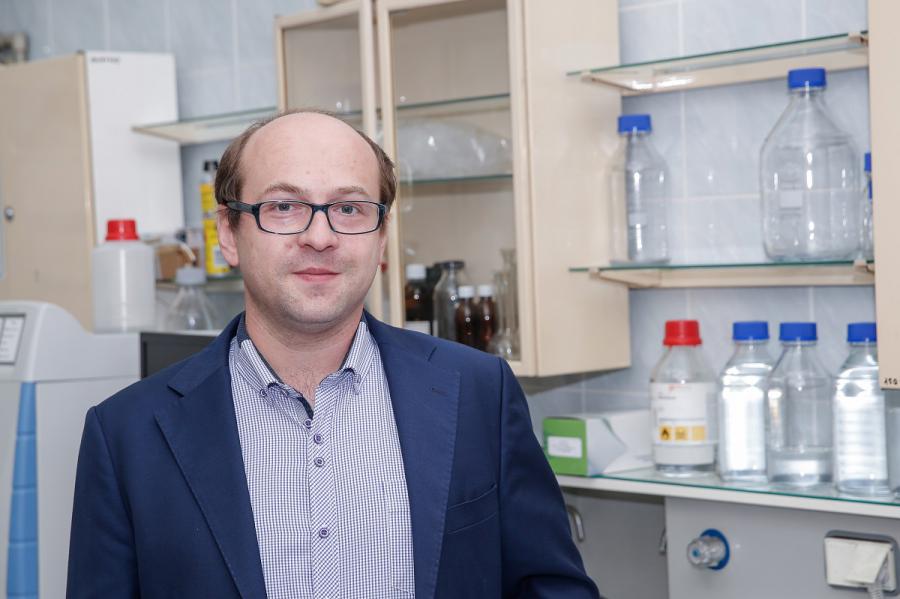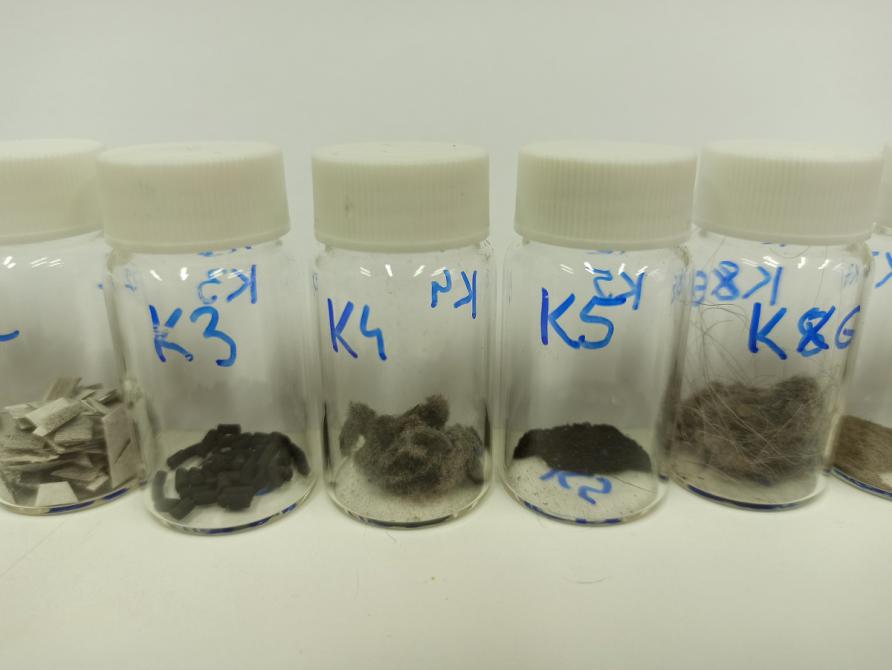RESEARCH EXCELLENCE INITIATIVE
FREEDOM OF RESEARCH – SCIENCE FOR THE FUTURE
‘Freedom of Research – Science for the Future’ series consists of articles, interviews and short videos presenting research conducted by the winners of the ‘Freedom of Research’ call for proposals
Paweł Świt, PhD, Eng.
Chemical investigations in daily life
| Weronika Cygan-Adamczyk |
From measuring the concentration of polycyclic aromatic hydrocarbons (PAHs) through analysing the amount of vanillin in food products to examining receipts and plastic packaging – analytical chemists search our surroundings for the presence of specific substances. Thanks to their research, we can determine, among other things, whether we actually eat what the manufacturer included in the composition printed on the packaging and whether the river flowing in the city centre does not spill harmful substances contained in it.
Paweł Świt, Paweł Świt, PhD, Eng. from the Faculty of Science and Technology of the University of Silesia focuses his scientific work on a spectrum of issues, examining samples of various origins. Above all, he is looking for solutions that will improve the quality of analytical results. Its aim is to develop new methods that are more effective in recognising certain substances and determining their concentration more precisely. He has already published many papers prepared together with colleagues from the University of Silesia.

Paweł Świt, PhD, Eng. | private gallery
Carcinogenic compounds in the environment
‘Polycyclic aromatic hydrocarbons (PAHs) play an unfavourable role in the environment. They have a very harmful effect on living organisms, including, of course, humans. They can even cause cancer’ explains the chemist from the University of Silesia. Together with Joanna Orzeł, PhD, and Sławomir Maślanka, PhD (also from the Faculty of Science and Technology) they determined the origin of the mentioned compounds in the Katowice area. The results of their work were published in the Journal of Hazardous Materials in 2023.
The origin of PAHs can be various. In nature, they are released as a result of volcanic activity, but they are also emitted in connection with human industrial activities. They are created when certain materials are burned. They can also be found in car exhaust fumes.
During the work carried out in Katowice, scientists took samples from the air (collected near ul. Szkolna and in the area of Dolina Trzech Stawów), house dust (including dust from the laboratory where chemists work), soil, snow, as well as Rawa and its sediment water. ‘We detected PAHs everywhere, although their concentrations could vary depending on the time of day at which we collected samples. The least amount of them was found in water (however, it all depends on the specific substance and weather conditions)’ explains Paweł Świt, PhD, Eng.
His task was to develop a new research method that would improve the quality of analytical results. PAHs are determined mainly using chromatographic techniques, but so far they were not helpful when taking into account the influence of other substances in the sample that may disturb the signal of the PAHs themselves. The scientist explains that the approaches currently being developed are based on combining reference substances in such a way as to eliminate interference effects that disturb the readings.
‘These effects may be of different nature: multiplicative, i.e. they affect directly proportional to the concentration of these substances, additive – they make a constant positive or negative contribution, or non-linear to the recorded signals. My research is about increasing the accuracy of the results to make them more reliable, closer to the real value’ says Paweł Świt, PhD, Eng.
Labels lie
Calibration of analytical methods is also important when we discuss food or drugs. Sometimes, when checking the actual chemical composition of the package contents, we come across compounds that should not be there, or those that the manufacturer does not mention. Faking food is a topic that has been mentioned quite often recently. The problem may have several sources.
‘Most often it is about reducing costs. Substitutes do not necessarily have to be harmful to the consumers, but they still mislead them. The average person will probably not notice something like this. Only in the laboratory can we determine whether there is too much of something in the product, or whether certain ingredients are missing’ explains the chemist.
Sometimes, grated carrot is added to coffee, which affects the colour of the product, and aditionally, makes the volume of the product appear bigger than in reality. Another example can be sweetening honey with, for example sucrose, adding various vegetable oils to olive oil, or adding pork to beef products.
As part of the Freedom of Research (Research Excellence Initiative) competition carried out at the University of Silesia, Paweł Świt, PhD, Eng undertook the development of an analytical method with increased accuracy to control the authenticity of vanilla flavours and detect food frauds using HPLC-ED and HPLC-DAD chromatography. The scientist emphasises that in the case of vanilla, the situation in the food market is very confusing.
Vanillin, one of the ingredients of vanilla, is found every day in various forms. We find it in baking powders, whole vanilla beans and vanilla paste. Synthetic compounds that are added to various products can serve as a way to adulterate vanilla, as a result of which we buy something different than the information on the label.
Paweł Świt, PhD, Eng is continuing his research under the Freedom of Research competition, looking for a method that will increase the accuracy of the results, including those related to the analysis of the ratios between vanillin and other substances detected in samples. The chemist explains the difference between the two chromatographic methods used in the project and where their advantages come from:
‘HPLC-DAD, i.e. high-performance liquid chromatography with diode matrix detection, allows the device to be examined using various electromagnetic wavelengths. On the basis of the 3D maps created, we can choose the exact wavelength at which we want to measure something. This creates more possibilities than analysis carried out at one wavelength. In turn, HPLS-ED is based on electrochemical detection, enabling work with low concentrations of compounds that would be more difficult to detect using other methods’ explains Paweł Świt, PhD, Eng.

Examples of dust samples used for the determination of PAHs | Photo by Paweł Świt, PhD, Eng.
Ubiquitous bisphenols
Another problem our chemists are dealing with is measuring the increasing exposure of the human body to bisphenols, found in numerous everyday objects. The topic of the joint work by Paweł Świt, PhD Eng. and Joanna Orzeł, PhD, published in January 2024 in the Journal of Chromatography A was a new method allowing for increasing the accuracy of research results.
The scientists determined three different compounds from the bisphenol group: BPA, BPF and BPS, known to disrupt human hormonal balance, although only the first of the substances mentioned are subject to guidelines limiting industrial and commercial use. The chemists focused on receipts, which were cut up to prepare a solution from their fragments, then they were filtered and analysed. In addition, they checked food stored in cans and other plastic packaging to find out whether substances that should not have been in the food had leached into it.
‘If we heat food in a container containing bisphenols or the container is damaged, due to e.g. scratches and abrasions, harmful compounds can enter the food more easily. Therefore, it would be best to give up plastic packaging or significantly reduce its use’ says Paweł Świt, PhD, Eng.
Although the work carried out by chemists concerns important issues, including the impact of various substances on the human body and those affecting the natural environment, commercial interest in using the methods they develop is relatively small. Meanwhile, the solutions being worked on by Paweł Świt, PhD, Eng fit into green chemistry and white chemistry – increasingly desirable on the market as they implement pro-ecological and economic assumptions. In the first case, we are dealing with environmentally friendly methods, e.g. limiting or eliminating the use of reagents that have a negative impact on fauna and flora. In turn, white chemistry includes activities that increase the effectiveness of research methods, speed up research procedures and reduce the consumption of reagents necessary in the process.
The scientist from the University of Silesia points out that the methods he is developing can be used in various areas: ‘For example, the same approach I use to determine the concentration of PAHs in the environment can also be used to analyse bisphenols, pharmaceutical or biomedical samples. The solutions we propose are constantly improved and their application possibilities are wide.
The article ‘Chemical investigations in daily life’ was published in the March issue of University of Silesia Magazine 6 (316).





